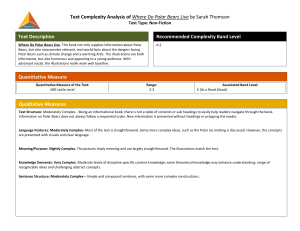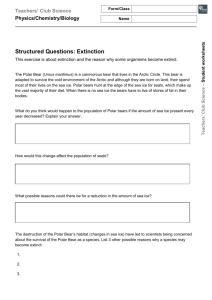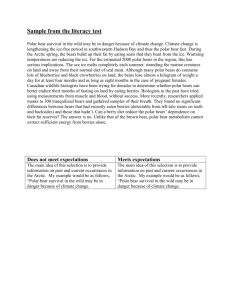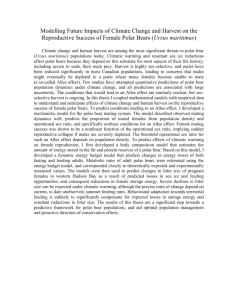word document
advertisement
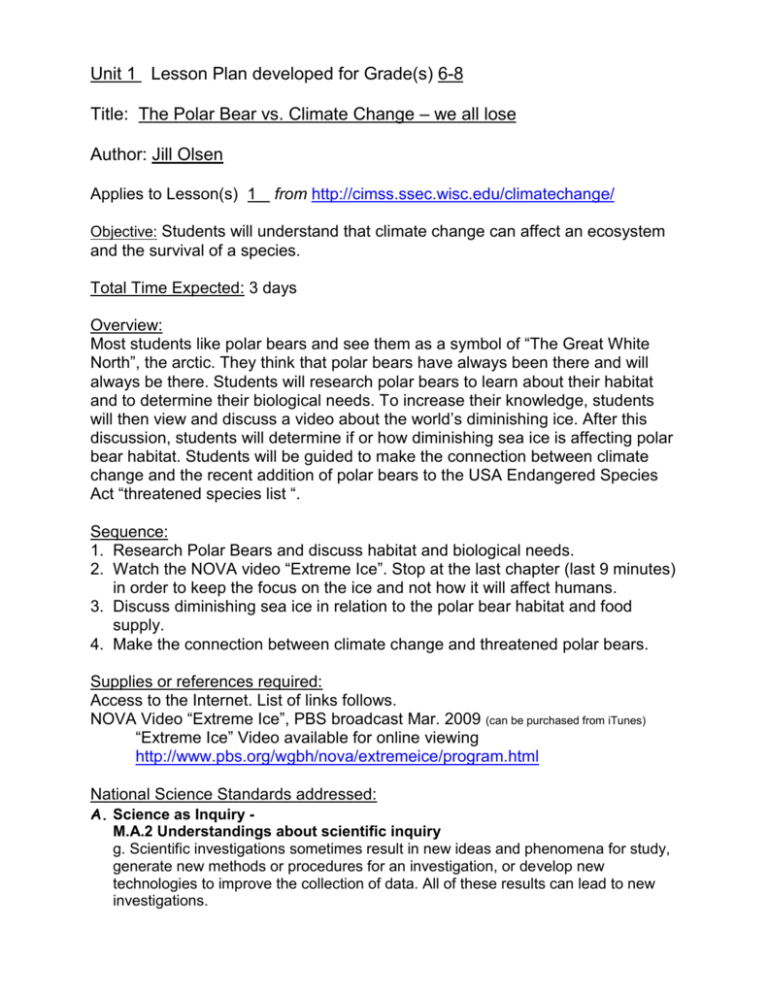
Unit 1 Lesson Plan developed for Grade(s) 6-8 Title: The Polar Bear vs. Climate Change – we all lose Author: Jill Olsen Applies to Lesson(s) 1 from http://cimss.ssec.wisc.edu/climatechange/ Objective: Students will understand that climate change can affect an ecosystem and the survival of a species. Total Time Expected: 3 days Overview: Most students like polar bears and see them as a symbol of “The Great White North”, the arctic. They think that polar bears have always been there and will always be there. Students will research polar bears to learn about their habitat and to determine their biological needs. To increase their knowledge, students will then view and discuss a video about the world’s diminishing ice. After this discussion, students will determine if or how diminishing sea ice is affecting polar bear habitat. Students will be guided to make the connection between climate change and the recent addition of polar bears to the USA Endangered Species Act “threatened species list “. Sequence: 1. Research Polar Bears and discuss habitat and biological needs. 2. Watch the NOVA video “Extreme Ice”. Stop at the last chapter (last 9 minutes) in order to keep the focus on the ice and not how it will affect humans. 3. Discuss diminishing sea ice in relation to the polar bear habitat and food supply. 4. Make the connection between climate change and threatened polar bears. Supplies or references required: Access to the Internet. List of links follows. NOVA Video “Extreme Ice”, PBS broadcast Mar. 2009 (can be purchased from iTunes) “Extreme Ice” Video available for online viewing http://www.pbs.org/wgbh/nova/extremeice/program.html National Science Standards addressed: A. Science as Inquiry M.A.2 Understandings about scientific inquiry g. Scientific investigations sometimes result in new ideas and phenomena for study, generate new methods or procedures for an investigation, or develop new technologies to improve the collection of data. All of these results can lead to new investigations. B. Physical Science M.B.3 Transfer of Energy b. Heat moves in predictable ways, flowing from warmer objects to cooler ones, until both reach the same temperature. C. Life Science – M.C.4 Populations and ecosystems d. The number of organisms an ecosystem can support depends on the resources available and abiotic factors, such as quantity of light and water, range of temperatures, and soil composition. Given adequate biotic and abiotic resources and no disease or predators, populations (including humans) increase at rapid rates. Lack of resources and other factors, such as predation and climate, limit the growth of populations in specific niches in the ecosystem. M.C.5 Diversity and adaptations of organisms c. Extinction of a species occurs when the environment changes and the adaptive characteristics of a species are insufficient to allow its survival. Fossils indicate that many organisms that lived long ago are extinct. Extinction of species iscommon; most of the species that have lived on the earth no longer exist. D. Earth and Space Science – M.D.1 Structure of the earth system j. Global patterns of atmospheric movement influence local weather. Oceans have a major effect on climate, because water in the oceans holds a large amount of heat. Related URLs or recommended reading: Polar Bears Kidzone: Polar Bears http://www.kidzone.ws/sg/polarbear/polar_bear.htm Polar Bears International http://www.polarbearsinternational.org/polar-bears/bear-essentials-polar-style National Geographic Kids http://kids.nationalgeographic.com/kids/animals/creaturefeature/polar-bear/ Polar Bears – Infobook Index http://www.seaworld.org/animal-info/info-books/polar-bear/index.htm National Geographic http://animals.nationalgeographic.com/animals/mammals/polar-bear.html Facts About Polar Bears http://www.polarbear-world.com/ Climate Change and Polar Bears Polar Bears and Global Warming http://www.polarbear-world.com/polar-bears-and-global-warming.html Endangered Species Program US Fish & Wildlife Service http://www.fws.gov/endangered/featured-species/index.html Effects on Wildlife and Habitat – National Wildlife Federation http://www.nwf.org/Global-Warming/Effects-on-Wildlife-and-Habitat.aspx Polar Bears International http://www.polarbearsinternational.org/polar-bears/faq


